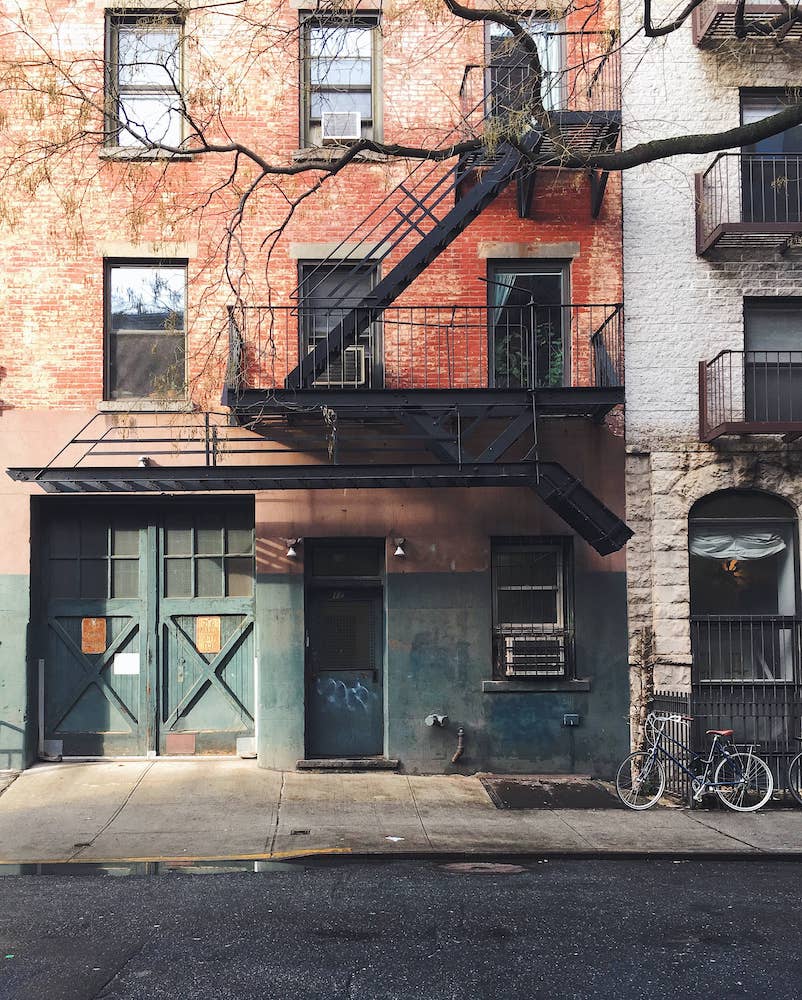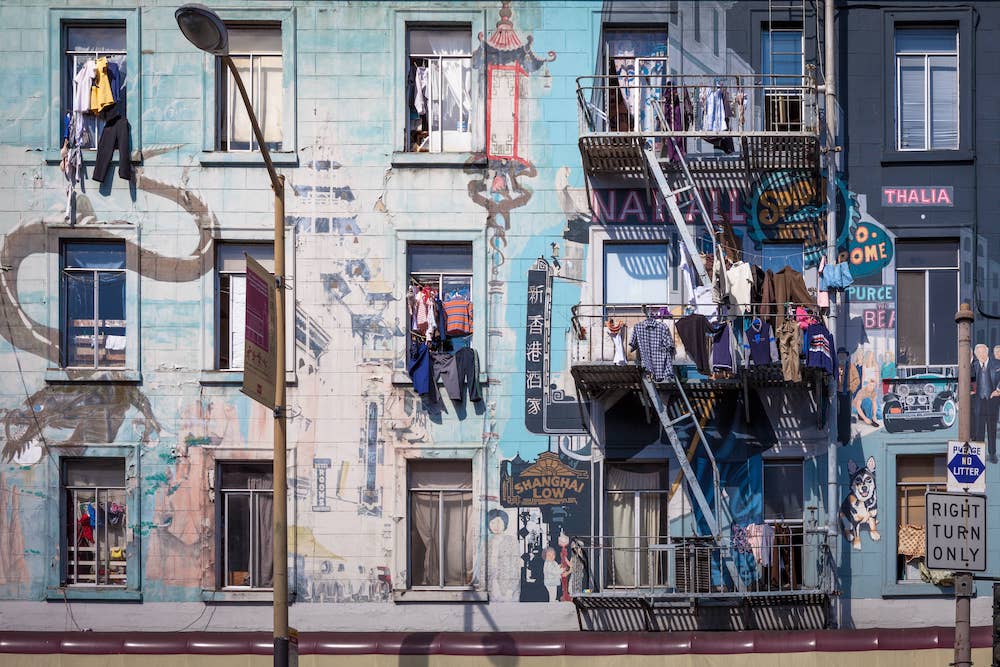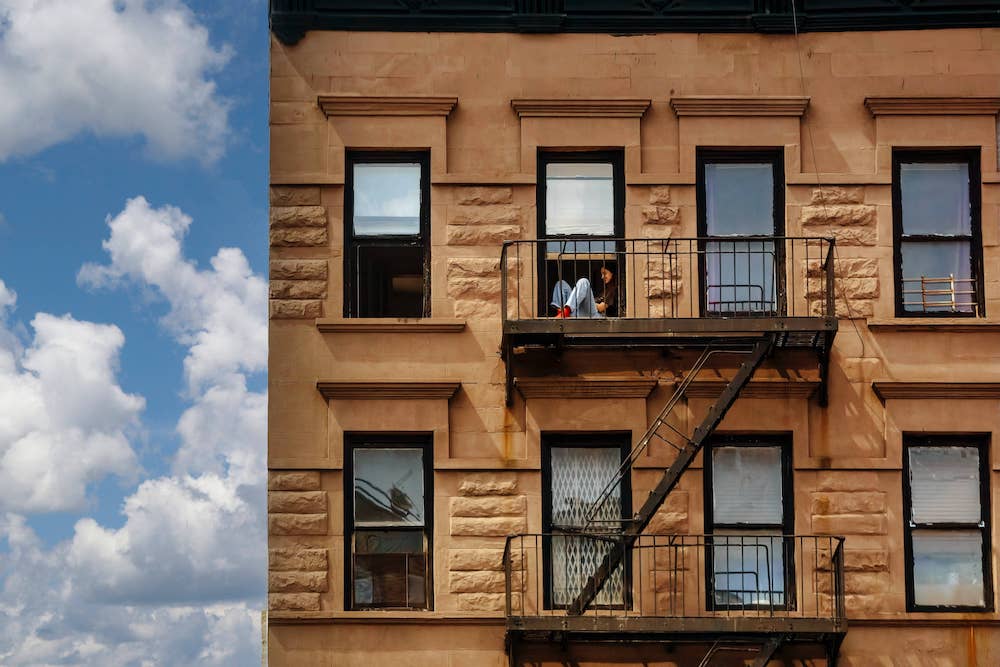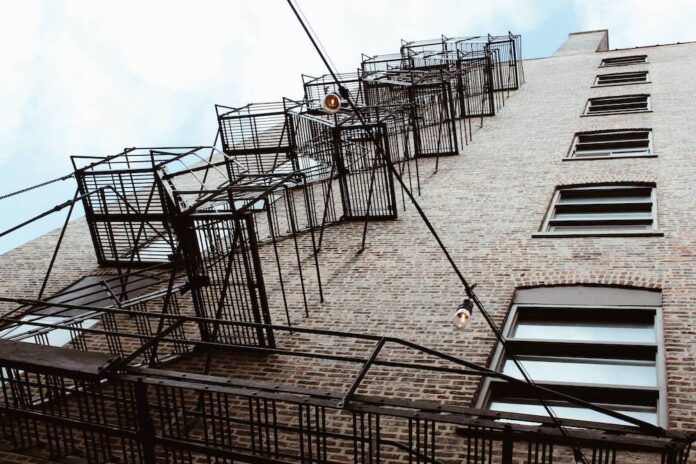If you look up at any given moment walking down a New York City street, you’re likely to be greeted with a familiar site: one of the city’s iconic fire escapes. These iron platforms and ladders adorn the sides of many historic buildings across the city, and they are as essential a feature of the city as the Statue of Liberty or Times Square. Though other cities have fire escapes, arguably nowhere has it been more widely embraced and implemented as in New York City. Their cultural appeal and aesthetic charm make them a fixture in film and television, such as being featured in Alfred Hitchcock’s Rear Window in 1954 or perhaps most notably in Jerome Robbins’ 1961 West Side Story. The story of the New York City fire escape predates the musical by approximately 150 years; although it is not nearly as charming or romantic as the images, they conjure for many of us today.
Early History of the fire escape in New York City
Early examples of fire escapes can be traced back to a bustling 1700s London, where solutions had to be posed to the surging population in urbanized areas due to the Industrial Revolution. As buildings got taller, more tenants, workers, and families became endangered by an epidemic of fires that ravaged the city. English inventors created some early versions of fire escapes, though few of them would be recognizable to us today. Even so, these inventions were rarely utilized, and the fastest way to escape a fire remained either taking the stairs (which were often made of wood and burned out, making escape impossible) or to another nearby rooftop. This solution was ineffective for a couple of reasons: one being the fast-moving fires often made it to adjacent buildings first, and the second was that adjacent buildings were often either taller or stories shorter than the one burning. A better solution was needed as advancements in technology, and larger and larger factories brought more and more people to industrialized cities across the world.
Why does NYC have fire escapes?
The fire escape as we know them in New York City is the result of several codes and laws created to address these same issues in a rapidly industrializing America. The first of these major codes was implemented in the 1800s when the population of New York City doubled every decade from 1800 to 1880. This was largely due to the Industrial Revolution, which found many Europeans migrating to the city for work in factories that were just as tall as some of the tallest residential buildings at the time. Many of these workers had no other choice but to find housing in cheaply built and poorly maintained Tenement Row houses, packing large quantities of workers and families into buildings made of dangerously flammable material. Historians estimate approximately 50% of the fires in New York City at the time took place in such structures.
What are fire escapes made out of?
The 1860s saw some of the worst of these fires but also the first concrete laws that would lead to our modern fire escapes. A Bakery Fire on the ground floor of a tenement building housing 24 families led to the 1867 First Tenement Act, which, in addition to setting room size, ventilation, and sanitation standards, also set a requirement for a fire escape in each suite and a window for every room. These fire escapes were required to be made of iron, stone, and wood, where our pop-culture image of the fire escape begins to take shape. These requirements specifically affected buildings over four stories tall, while landlords of shorter buildings were simply admonished to keep their buildings in” safe conditions.” Our modern depiction of fire escapes was born as a cheap solution and an easy way to skirt these new regulations.

Are there other types of fire escapes?
However, these iron staircases were far from the only solutions proposed at the time. Inventor Lewis Anidjah, for instance, patented a fire-proof canvas slide similar to those on airplanes, while a 1909 patent by Pasquale Nigro calls for the implementation of fireproof “wings” to be attached to persons escaping the building. The design most landlords settled on was what we see still installed on many historic buildings across the city. These are cheaply made iron ladders and stairs that could easily be affixed to the side of existing buildings and incorporated into new construction. Landlords at the time were no more scrupulous than those of modern times, and many of them opted for this option even though it was proven ineffective and even dangerous very early. Even still, this design was immensely popular, to say the least, and thanks to the tenement act of 1901, tens of thousands of these iron ladder and stairs types of fire escapes were newly built or used to replace older installations as landlords were given stricter guidelines for the structures.
Why don’t I see fire escapes on newer buildings?
Following a 1938 update to the NYC Building Code and numerous laws since fire escapes were not needed as protected interior stairwells for all new constructions were acceptable replacements. While landlords were slow to adapt to these new recommendations, they’re now universally required by another 2004 change to the code requiring protected stairwells and sprinklers in buildings over 40 feet tall (something many buildings in NYC still don’t have). By this point, most pre-code fire escapes in the city are at least 50 years old, and some are over 100! These requirements, along with other updates to the code, largely eliminate the need for fire escapes on new constructions.

Will NYC ever remove my fire escape?
Tenants who have fire escapes are likely to use their fire escapes, and that means these decades-old structures made of (often rusted) iron must retain their structural integrity enough for these activities to take place. There have been efforts to remove fire escapes from older buildings as modern improvements have rendered them redundant, and many see keeping them as a danger to residents of under-maintained buildings. Not only would this require a gargantuan effort on behalf of the City of New York, but many of these structures were also built in the 1800s and early 1900s; they are on historically protected buildings and are, by extension, themselves unable to be removed. This means that we’re unlikely to see a mass removal of fire escapes from the city in our lifetimes; a good thing to many who see them as an essential feature of New York’s cultural and historic identity. For example, this SoHo loft (seen below) would not have its quintessential look without the fire escapes you see out the window.

Are fire escapes dangerous?
Fire escapes have sometimes proven ineffective in the case of fire, collapsing, folding, or even melting in the heat, as it did in the famous Triangle Shirtwaist Factory fire on March 25th, 1911. There are several modern accounts of fire escapes taking lives outside of emergency situations, such as in the 2015 death of Broadway Star Kyle Jean-Baptiste or a Soho man who was killed in 2018 by a piece of fire escape that failed and fell seven stories. A combination of age, lax code enforcement, and wear-and-tear has left much of this architecture dangerously under-maintained. The New York City fire escape is as beautiful as it is flawed, though fortunately, you’re unlikely to need yours in the future, thanks to modern building codes.
More on CitySignal:
What can I legally do with my fire escape?
Seeing as many buildings in the city are older than 1968, many of us have fire escapes and wonder what we can do with the iconic piece of architecture affixed to our building. The short answer is – legally? Not much. The Fire Department of the City of New York (FDNY) doesn’t want you to use your fire escape for anything but that – escaping. Firstly there’s safety. While landlords are required to perform routine inspections and keep them up to code, modern fire escapes have failed and collapsed in several instances, causing major damage to the building and harm to inhabitants. A combination of rust, oxidation, and age makes stepping out on any under-maintained fire escape a risk. The Fire Code of New York City also prohibits blockage of the fire escape and use of the platform for storage, although many do.
Can I sit on my fire escape?
But rest assured, standing or sitting on your fire escape is perfectly legal; no need to say goodbye to quick breathers or a night stargazing. Just be sure it’s well-inspected, safe, and up to code: which, if you’re a renter in New York City, is a codified right of yours. If you feel worried about the state of your fire escape and don’t believe it’s being well maintained, there are several legal actions, according to Local Law 11, you can take to make sure your landlord keeps your fire escape up to code. The International Fire Code requires a certified engineer to evaluate, repair, and repaint your fire escape every 5 years if it’s over six stories tall. If you know, it’s been longer than that, or your fire escape looks to be in disrepair, familiarize yourself with your rights.

What about my fire escape garden?
All that being said, many have found creative ways to use their fire escapes for fun and utility. We’ve all seen classic images of clotheslines draped from building to building, and garments drying in the sun on the fire escape. Another popular use is a fire escape garden, though not strictly legal due to the requirements around storage and blockage of the platform. One could argue it’s not illegal so long as the plants do not block access to the platform, although that’s up to your landlord, building codes, and local fire department. Other interesting examples of things done with fire escapes include do-it-yourselfers transforming their fire escape into breakfast nooks and artists creating installations with paint behind and across the iron bars. Recently in Harlem in 2020, musicians performed impromptu jam sessions with their musical instruments outside on their fire escapes to entertain and uplift isolated neighbors.
Whether enjoyed for their old-fashioned charm and visual appeal or for a simple and quick escape to one’s little patio, fire escapes in New York City are here to stay, even if they’re unlikely to save you from an actual fire in the future. The next time you look up and see one of these ancient structures, I hope you remember the centuries of innovation and ingenuity that ultimately led to the technology that keeps us safe from fires today. These old iron ladders and staircases possess a surprisingly complex and sordid past, representing not only humanity’s worst tendencies toward greed and rule-skirting but also the best of humanity’s efforts in preserving life.
Josiah Thomas Turner is writer and musician based out of Washington Heights, New York. Turner received his undergraduate degree in Drama from the University of Wisconsin - Stevens Point before earning an M.F.A. in Playwriting from The University of Texas at Austin. Born and raised in Milwaukee, Wisconsin, Turner trained as a multi-instrumentalist from a young age and spent much of his early years creating and performing music. Josiah’s current interest include animation, video-games and French-Canadian prog-rock.



